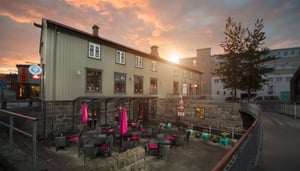Sólheimajökull Ice Climbing Tour
47 Reviews
Outdoor sports
Outdoor activities
Tours
Day trips
Day Trips From
Nature & adventure
Snow & winter sports
Extreme sports & adrenaline
Climbing experiences
Explore one of the best places to try out ice climbing in Iceland on a day trip from Reykjavik.
Highlights
- Experience the true nature of Sólheimajökull glacier
- Enjoy the south coast of Iceland
- Learn the basic ice climbing skills and explore the glacier
- See Skógarfoss and Seljalandsfoss waterfalls
- Explore the glacier
Description
Begin at the Sólheimajökull parking lot where you are provided with the glacier gear required for the trip. Then undertake a 15-minute hike on a gravel road to the base of Sólheimajökull. At the base, you will be shown how to put on and use the gear.
Once on the glacier, you climb on an easy ice wall to learn the basic skills and techniques of ice climbing. We need to walk between climbing spots so you can explore the stunnig landscape of the glacier. After that, you will try to climb in two - three different locations on the glacier, either at a nice wall or a hole (called a mulian) that you can get into and climb back up.
This climbing tour is a interdiction so every one can do it.
You dont have to be a super fit person to enjoy this.
Wy book with us?
We offer small number of people in each tour. All of our guides are professional mountain guides and ice climbers.
Sólheimajökull is a small outlet glacier coming from the Mýrdalsjökull ice cap. This is one of the closest glaciers to Reykjavík and takes about 2 hours and 20 minutes to drive there. Mýrdalsjökull, the mire valley glacier, is an ice cap in the south of Iceland. It is to the north of Vík and to the east of the smaller ice cap Eyjafjallajökull. Between these two glaciers is Fimmvörðuháls pass. Its peak reaches 1,493 meters (4,898 foot) and in 1980 it covered an area of 595 kilometers squared (230 square miles). The icecap of the glacier covers an active volcano called Katla. The caldera of the volcano has a diameter of 10 kilometers (6 miles) and the volcano erupts usually every 40 to 80 years. The last eruption took place in 1918. Scientists are actively monitoring the volcano, particularly after the eruption of nearby Eyjafjallajökull began in April 2010.
Includes
Glacier gear including harness, crampons, helmet, and ice axe
Local guide
Important Information
- This tour is a beginner or introduction level so no special skills are needed
- It is recommended to bring lunch or snacks
We need a minimum of two participants to go-ahead with this tour.
Easy cancellation
Cancel up to 24 hours in advance for a full refund

